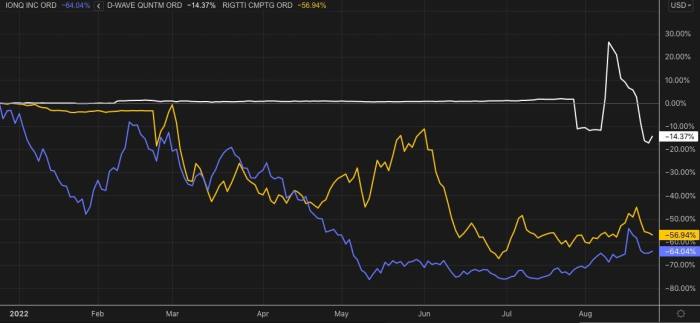The quantum computing bubble
Nikita Gourianov is a physicist at Oxford university that works with computational quantum physics. Here he argues that people have become wildly over-optimistic on the prospects of quantum computing.
Financial bubbles occur when large groups of investors repeatedly make poor investment decisions, often due to greed, misunderstanding and easy money. A modern-day example of this is quantum computing.
Quantum computing is often portrayed as an up-and-coming technology whose eventual impact will only be rivalled by artificial intelligence. According to the quantum evangelists, it is only a matter of time before a fully-functional quantum computer will appear and do everything from revolutionising drug development to cracking internet encryption schemes.
Billions of dollars have poured into the field in recent years, culminating with the public market debuts of prominent quantum computing companies like IonQ, Rigetti and D-Wave through 2021’s favourite frothy market phenomenon, special purpose acquisition vehicles (Spacs).
These three jointly still have a market capitalisation of $3bn, but combined expected sales of about $32mn this year (and about $150mn of net losses), according to Refinitiv. Here’s what their stocks have done this year.
The reality is that none of these companies — or any other quantum computing firm, for that matter — are actually earning any real money. The little revenue they generate mostly comes from consulting missions aimed at teaching other companies about “how quantum computers will help their business”, as opposed to genuinely harnessing any advantages that quantum computers have over classical computers.
The simple reason for this is that despite years of effort nobody has yet come close to building a quantum machine that is actually capable of solving practical problems. The current devices are so error-prone that any information one tries to process with them will almost instantly degenerate into noise. The problem only grows worse if the computer is scaled up (ie, the number of “qubits” increased).
A convincing strategy for overcoming these errors has not yet been demonstrated, making it unclear as to when — if ever — it will become possible to build a large-scale, fault-tolerant quantum computer. Yet according to the evangelists, we are apparently in the middle of a Quantum Moore’s Law (aka “Rose’s Law”, after D-Wave founder Geordie Rose) analogous to the microchip revolution of the 1970s — 2010s.
Another fundamental issue is that it is unclear what commercially-useful problems can even be solved with quantum computers — if any.
The most prominent application by far is the Shor algorithm for factorising large numbers into their constituent primes, which is exponentially faster than any known corresponding scheme running on a classical computer. Since most cryptography currently used to protect our internet traffic are based on the assumed hardness of the prime factorisation problem, the sudden appearance of an actually functional quantum computer capable of running Shor’s algorithm would indeed pose a major security risk.
Shor’s algorithm has been a godsend to the quantum industry, leading to untold amounts of funding from government security agencies all over the world. However, the commonly forgotten caveat here is that there are many alternative cryptographic schemes that are not vulnerable to quantum computers. It would be far from impossible to simply replace these vulnerable schemes with so-called “quantum-secure” ones.
And the uncertain practical viability of Shor’s algorithm is only the tip of the iceberg. There has been much controversy regarding where and when quantum computing can actually offer any practical advantage. The latest research points out that there is no evidence that even quantum chemistry calculations can be significantly sped up with quantum computers. That is bad news for the much-touted idea of quantum computers being useful for drug design.
In essence, the quantum computing industry has yet to demonstrate any practical utility, despite the fanfare. Why is then so much money flowing in? Well, it is mainly due to the fanfare. The views of scientists are still (mostly) respected in society, and so when physicists get excited about something, people notice.
The excitement truly began in the 90s, which saw a range of pioneering breakthroughs that truly marked the birth of quantum technologies as an academic field. As more progress was made over the years, the excitement grew, eventually going well beyond the community.
By the 2010s capital had become cheap, and investors started taking notice, even if they had no real understand of the technology (beyond the “a qubit can simultaneously be both one and zero” cliché). As more money flowed in, the field grew, and it became progressively more tempting for scientists to oversell their results. With time, salesman-type figures, typically without any understanding of quantum physics, entered the field, taking senior positions in companies and focusing solely on generating fanfare. After a few years of this, a highly exaggerated perspective on the promise of quantum computing reached the mainstream, leading to a greed and misunderstanding taking hold and the formation of a classical bubble.
Some physicists believe, in private, that there is no problem here: why not take advantage of the situation while it lasts, and take the easy money from the not-too-sophisticated investors? Earning a private-sector level salary whilst doing essentially academic research is a pretty good deal, after all.
Well, when exactly the bubble will pop is difficult to say, but at some point the claims will be found out and the funding will dry up. I just hope that when the music stops and the bubble pops, the public will still listen to us physicists.
